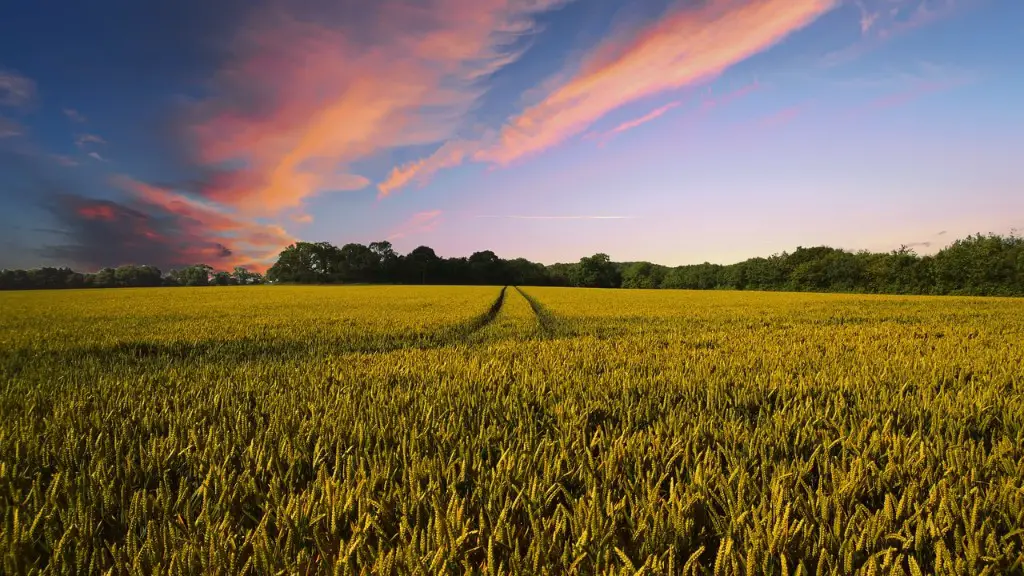Climate change is one of the most pressing global issues of our time, and agriculture is a major contributor to greenhouse gas (GHG) emissions. But it doesn’t have to be this way! There are a number of practical methods that farmers and ranchers can use to reduce GHG emissions on their operations.
There are a number of practices that farmers and ranchers can use to reduce greenhouse gas (GHG) emissions from agriculture. These include:
• Improving crop and livestock productivity through better management practices
• Using low or no-tillage production systems
• Using cover crops and crop rotations
• Applying manure and other organic matter to soils
• Improving irrigation water use efficiency
• Reducing methane emissions from livestock
How can we reduce agriculture emissions?
No-till farming and animal-raising techniques that include rotational grazing, deep-bedding animals and composting manure are among the most sustainable and reduce the amount of greenhouse gas emissions.
Agricultural greenhouse gas emissions make up a significant portion of total emissions and come from a variety of sources. Livestock, such as cows, are a major source of agricultural emissions, as are agricultural soils and rice production. Reducing emissions from these sources will be critical to achieving global climate goals.
How can we stop global warming in agriculture
Climate change is one of the biggest challenges facing farmers today. But there are things farmers can do to fight back. Here are 10 ways farmers can help fight climate change:
1. Efficient Irrigation Management: By using irrigation techniques that reduce water waste and improve water efficiency, farmers can help conserve this precious resource.
2. Renewable Energy: Utilizing renewable energy sources like solar and wind can help farmers reduce their reliance on fossil fuels and shrink their carbon footprint.
3. Organic Practices: Using organic farming practices can help improve soil health, which can in turn help sequester carbon and reduce greenhouse gas emissions.
4. Increasing Soil Health: Healthy soils are more efficient at sequestering carbon, so by improving soil health, farmers can help fight climate change.
5. Keeping Agriculture Green: Preserving and re-establishing green space on farms can help reduce greenhouse gas emissions and provide important habitat for wildlife.
6. Reducing Livestock Methane Emissions: Methane is a powerful greenhouse gas, and livestock are a major source of methane emissions. But there are things farmers can do to reduce these emissions, like using methane digesters and changing livestock feed.
7. Past
There are many ways to reduce enteric fermentation and emissions from manure management. New technologies can help to reduce emissions and improve manure management. Improved manure management can help to reduce emissions from manure left on pasture. Increasing nitrogen use efficiency can help to reduce emissions from fertilizers. Emissions-reducing rice management and varieties can help to reduce emissions from rice production.
What are 3 ways to reduce emissions?
Here are 10 easy ways you can start making a difference:
1. Stop buying your water in plastic
2. Incorporate walking or biking to some of your regular short-trip destinations
3. Turn off lights and unplug devices when you’re not using them
4. Keep the tires on your car properly inflated and get regular tune-ups
5. Bring your own bags to the grocery store
6. compost your food scraps
7. reduce your energy consumption
8. recycle
9. support renewable energy
10. volunteer for a local environmental organization
Livestock methane emissions are the number one contributor to agricultural greenhouse gases globally. Cows belching is the main source of these emissions, which have a significant impact on climate change.
What are 5 agricultural practices that lead to the increase in greenhouse gasses?
Good agricultural practices can help to mitigate GHG emissions from agriculture. This includes practices such as agroforestry, improved livestock management, and soil carbon sequestration. Agroforestry can help to sequester carbon in the soil and biomass, and improve soil fertility and crop yields. Improved livestock management practices can help to reduce methane emissions from livestock. Soil carbon sequestration can help to mitigate agricultural GHG emissions by keeping carbon in the soil instead of releasing it into the atmosphere.
Sustainable pasture and livestock management systems are key to reducing methane emissions from agriculture. By investing in more efficient water usage, including irrigation practices, and testing new technologies that help boost farming efficiencies, farmers can help reduce methane emissions.
How agriculture can positively impact greenhouse emissions
Climate change is one of the most pressing issues of our time, and agricultural production plays a significant role in both causing and mitigating its effects. Greenhouse gas emissions from agricultural production make up about 10% of the total global emissions that contribute to climate change. So, finding ways to reduce these emissions is an important part of the puzzle.
Fortunately, there are a number of ways that agriculture can be part of the solution. One is by increasing carbon sequestration in soil. This can be done through practices like no-till farming and using cover crops, which keep more carbon in the soil instead of releasing it into the atmosphere.
In addition, agriculture can produce biofuels, which can substitute for fossil fuels and reduce greenhouse gas emissions across multiple sectors. These actions are considered forms of climate change mitigation.
So, while agriculture is a major contributor to climate change, it also has the potential to be part of the solution. By implementing climate-friendly practices, we can help mitigate the effects of climate change and make a difference for the future of our planet.
If farmers produced more food from plants and less from livestock, methane emissions from agriculture would likely be reduced. Also, emissions at landfills could be captured if more attention is given to this issue.
What are 4 examples of strategies to reduce carbon emissions?
There are many things that humankind can do in order to help reduce carbon emissions. Some of these things include reducing air travel, making driving more efficient, planting trees, switching to clean energy, and eating less red meat. Additionally, making your home more energy-efficient is another way to help reduce carbon emissions. Every little bit helps and by doing our part, we can collectively make a difference.
There are various ways to increase soil carbon, which is important for sequestering carbon and mitigating climate change. Reducing soil disturbance, planting perennial crops, and changing planting schedules or rotations can all help to increase soil carbon. Managed grazing can also help, by increasing the amount of organic matter in the soil.
What are 7 steps you can take to reduce greenhouse gas emissions
Climate change is one of the most pressing issues of our time, and we all need to do our part to reduce greenhouse gas emissions. Here are some things you can do at home to make a difference:
1. Get a home energy audit. A professional can help you identify ways to make your home more energy-efficient, which can save you money and help the environment.
2. Use renewable energy. If you have the option to purchase renewable energy from your utility company, do it! Even a small percentage can make a difference.
3. Purchase solar panels. Solar panels can help reduce your reliance on fossil fuels and lower your energy bills.
4. Buy green tags. Green tags are a type of carbon offset, and purchasing them can help support projects that reduce greenhouse gas emissions.
5. Adjust your thermostat. Heating and cooling your home uses a lot of energy, so try to keep your thermostat at a comfortable, yet energy-saving, level.
6. Install solar lights. These are a great way to reduce your electricity usage and save money on your energy bill.
7. Use energy-saving light bulbs. Switching to compact fluorescent bulbs can save you money and
There are a lot of things we can do to help combat the climate crisis. Here are ten things you can do to start making a difference:
1. Save energy at home by making simple changes like switching to LED light bulbs and turning off electronics when you’re not using them.
2. Walk, bike, or take public transportation whenever possible to help reduce emissions from cars and trucks.
3. Eat more vegetables! Plant-based diets require less water and energy to produce than meat-based diets.
4. Consider your travel options carefully. If you can take a train or bus instead of flying, do it!
5. Throw away less food. PLAN your meals and only buy what you need to reduce food waste.
6. Reduce, reuse, repair, and recycle as much as possible to cut down on the amount of waste we produce.
7. Change your home’s source of energy to renewable options like solar or wind power.
8. Switch to an electric vehicle. EVs are much more efficient than gas-powered cars and produce zero emissions.
9. Educate yourself and others about the climate crisis. The more people are aware of the problem, the
What is the most effective policy to reduce emissions?
A carbon tax is an effective policy for reducing CO2 emissions because it encourages businesses to find ways to reduce their emissions. The tax is applied upstream in the fossil fuel supply chain in proportion to the carbon content of each fuel, with refunds for any downstream capture of emissions by CCS. This tax system fully covers potential releases of CO2 from later fuel combustion.
There are four main factors that contribute to successful greenhouse environmental control: heat, humidity, ventilation, and sunlight. Each of these elements must be carefully monitored and controlled in order to create a hospitable environment for your plants.
Heat is an important factor to consider, as some crops cannot tolerate high temperatures while others actually prefer it. Humidity is also an important consideration, as too much or too little moisture can adversely affect plant growth. Ventilation is crucial for maintaining a comfortable environment inside the greenhouse, as well as ensuring that the plants get the CO2 they need for photosynthesis. Finally, sunlight is essential for plant growth, so the greenhouse must be designed in such a way that it receives adequate lighting.
What are 5 environmental factors that affect the agriculture industry
The nature of the terrain, climate, and soil all play a role in how much arable land is available forcrops.Sloped or very rocky terrain can be difficult to farm, while a warm, moist climate is ideal for many crops. The properties of the soil, including depth, fertility, and drainage, also affect how much land is available for farming.
Crop rotation is a common agricultural practice that involves growing a series of different crops in a designated order in the same space. Crop rotation leads to healthier soil and improved pest control methods besides promoting diversity. Intercropping and growing cover crops prevent soil erosion and also helps replenish nutrients along with minimising weeds. Managing irrigation to reduce runoff is another practice that helps prevent soil erosion.
Warp Up
There are a number of ways to reduce GHG emissions in agriculture:
1) Use no-till or low-tillage methods when planting crops. This helps to reduce soil disturbance and the release of GHGs.
2) Grow cover crops. This helps to improve soil health and sequester carbon in the soil.
3) Use animal manure as a fertilizer. This helps to improve soil health and reduces the need for synthetic fertilizers, which release GHGs.
4) Use efficient irrigation methods. This helps to reduce water usage and the associated GHG emissions.
5) Use energy-efficient equipment and techniques. This helps to reduce fuel use and GHG emissions.
One way to reduce greenhouse gas emissions in agriculture is to use more efficient irrigation systems. Drip irrigation and other efficient irrigation systems can help reduce the amount of water and energy used in agriculture, which can lead to fewer greenhouse gas emissions. Other ways to reduce emissions in agriculture include using more efficient equipment, reducing animal waste, and using cover crops.





